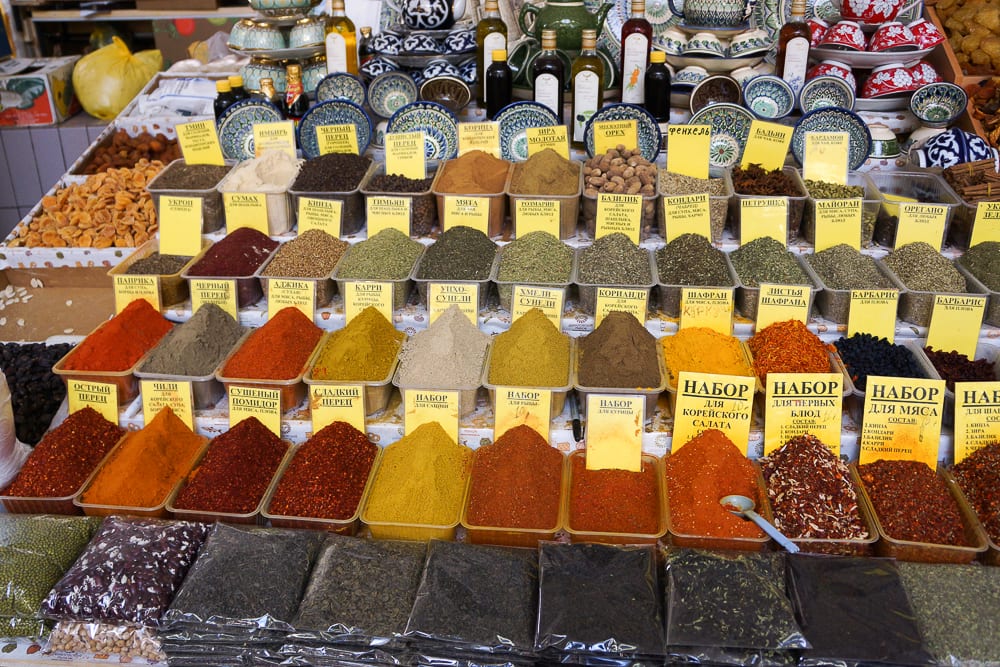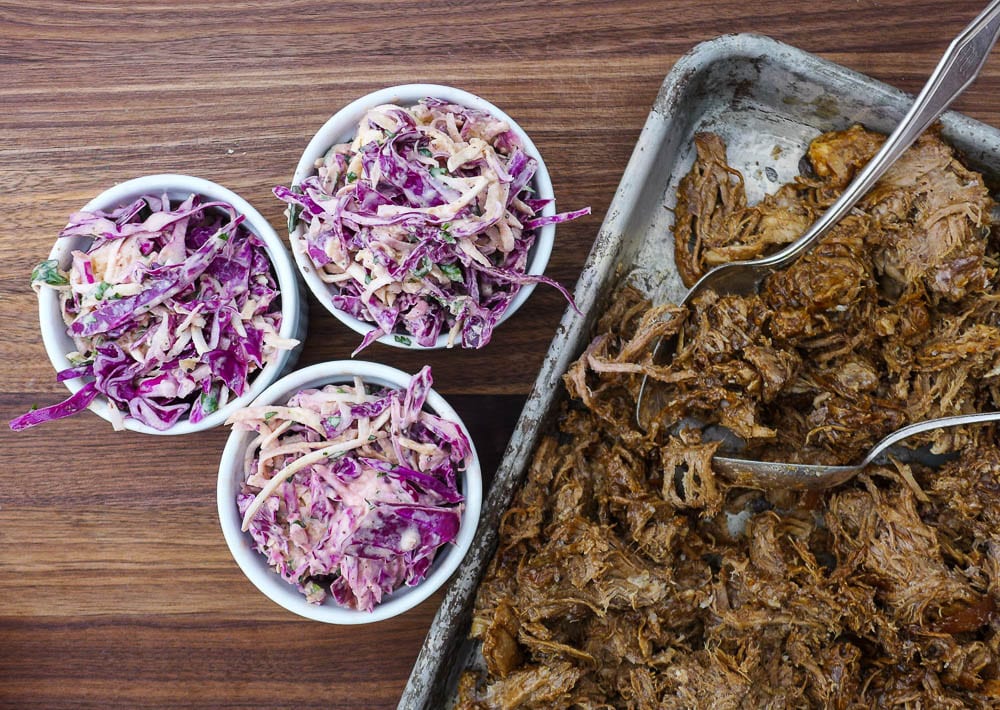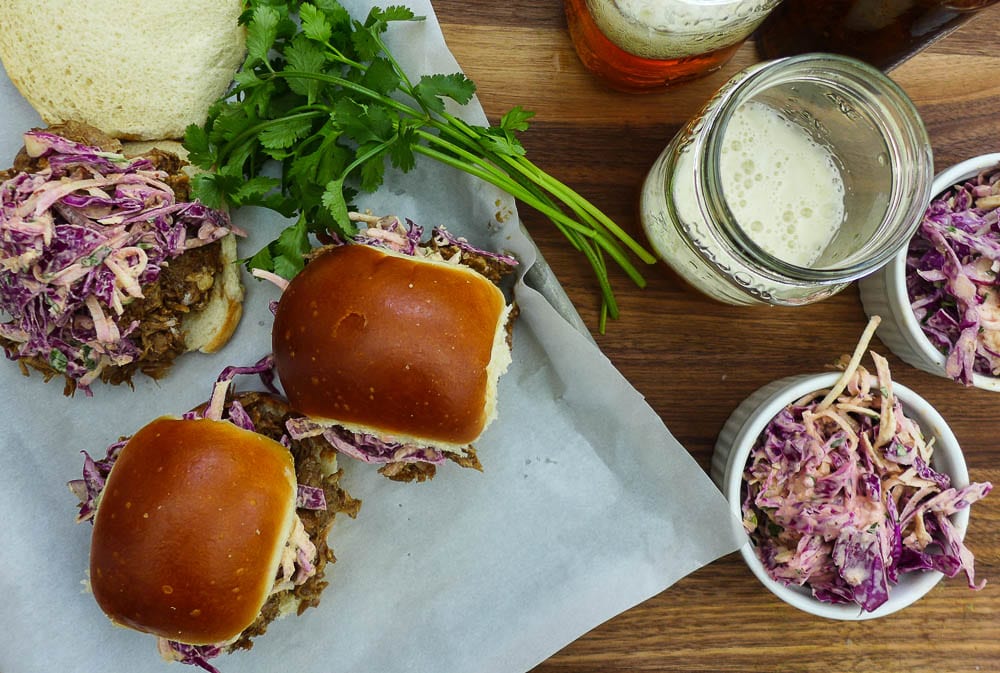If you think Pulled Pork is confined to an American Red State Super Bowl party, think again!
Making Oven Pulled Pork In Moscow
Pulled Pork has been making its steady way across the Atlantic for a few years now: it’s white hot in Sweden, where they can’t get enough of it, and rumor has reached me of a French version, though I will require a lot more evidence to credit that one. So I thought is was time to lure this succulent soul food staple across the Iron Curtain (you know, before it gets too impenetrable) and let it take up residence here in the Russian capital.
Pulled Pork is a good solution to our current culinary-challenged times. A good rub and a low and slow braise goes a long way to making an indifferent piece of meat into something that has a great depth of flavor and a pleasing texture. I read up extensively on Pulled Pork to see how I could bring it out of the barbecue pit and into our Moscow kitchens, where, let’s face it, we don’t have barbecue pits, nor easy access to bottles of “Hickory Smoke” elixir, or tins of “Cajun Rub.”
So instead of trying to fake the flavors of the American South, I auditioned some alternative flavor combinations, and decided that the mildly spicy, pungent, slightly sweet flavors of Uzbek cuisine would make sense for Pulled Pork. After all, plov, Central Asia’s headliner dish, is also a “low and slow” affair, which infuses meat and rice with a redolent mix of spices.

Photo Credit: Jennifer Eremeeva – Central Asian, Russian, and Caucasian Spices sold in bulk at Danilovsky Market
Because the meat we get right now in Moscow can be on the tough side, my strategy is always to either marinate, brine, or rub it for a good 12-18 hours before cooking begins. The pre-mixed plov medley (with a few generous tablespoons of good kosher salt added in) sold at all spice sections of Russian farmers’ markets makes for an excellent rub. Those guys at the market are very cagey about divulging the exact mix in the medley, but I’ve clubbed together a fairly good approximation. If you like your pork on the spicy side, then, by all means, add a bit more chili pepper to the mix. Rubs are not meant to be an exact science.
I can’t finish without acknowledging, Kelly Seynei of JustATaste.com. Kelly is one of my culinary brain crushes. Her delightful blog offers up just the kind of nosh we all need in our busy lives: tasty, relatively fuss-free: ideal for getting stuff on the table without a lot of hassle when you’ve got a crowd over. Her Slow Cooker Balsamic Honey Pulled Pork was my first foray into oven cooked pulled pork. Central Asian Oven Pulled Pork is very much a riff on her excellent version of this Southern Favorite. Thank you, Kelly, as ever, for inspiration and information served up in a delicious way!
Central Asian Oven Pulled PorkIngredients1 pork butt or shoulder about 2-3 kilos (4.5-6.6 lbs) Olive oil (236 ml)1 cup of Central Asian Spice Rub -3 Tbl of ground cumin -3 Tbl of ground coriander -1 Tbl of paprika -1 Tbl of sumac – 2 tsp of dried tarragon -1 tsp of chili powder -4 Tbl of kosher salt 1 tsp of white peppercorns, ground 236 ml (1 cup) of chicken broth 175 ml (3/4-cup) balsamic or black rice vinegar 125 ml (1/2-cup) of pomegranate syrup 125 ml (1/2-cup) of honey 125 ml (1/2-cup) of blackberry jam 175 ml (3/4-cup) of hoisin sauce 4 garlic cloves, mashed and minced 1 Tbl of crushed coriander seeds 1 small red onion, finely diced 60 ml (1/4-cup) of dried currents, raisins, or prunes 30 ml (2 Tbl) of cornstarch 90 ml (6 Tbl) of cold water Instructions:
Ideas on Serving:Pulled pork is delightfully versatile. To keep the Central Asian/Silk Road theme going, you can roll the pulled pork up in flat “lavash” type bread. Hamburger buns or mini baguettes are great too, or you can just serve the pork on its own. Pulled pork is not normally served over rice or whole grains, but I don’t see why you shouldn’t do that either. Something tangy rounds this meal out perfectly. A selection of pickled vegetables or winter slaw is a great accompaniment. Be sure to save some of the lovely pot sauces to drizzle over and have some fresh coriander (cilantro) handy as a tangy accent garnish. How to Slow Cook without a Slow CookerTo imitate the “low and slow” cooking of a slow cooker in your oven, choose a heavy-bottomed Dutch oven, preferably a cast iron one, which can conduct the heat evenly and has a snug lid. Preheat the oven to 220℉/ 110℃ (or the lowest temperature your Celsius oven can achieve — many older Moscow ovens have a limited range) and prepare a piece of parchment paper that is 1” larger in diameter than the mouth of your pot. Once the the prep is complete (steps 4-8), place the parchment paper over the pot, then place the lid firmly on top. Cooking time in the oven will vary based on the pot you use and your oven so start checking after hour # 7. Where to find these ingredientsPork: I still think the farmers’ markets are your best option and you can get the guys to cut and trim the meat for you. Alternatively, look at a reliable supermarket such as Metro, Auchan, or Perekrostok. Hoisin sauce and rice vinegar are still easily found in the Asian sections of most supermarkets, and pomegranate syrup is usually found nearby in the Caucasian sauce section. The spices you need are available at the farmers’ market. For help with translation and pronunciation of these ingredients in Russian, download my handy shopping lists! Recipe based on Slow Cooker Balsamic Honey Pulled Pork from JustATaste.com |
Hello there, Readers!
Do you have a home country favorite you’d like adapted to Moscow conditions? Be sure to let me know about it by hitting the comment button below! Some of my favorite recipe ideas have come from people scratching their heads about how to replicate an ingredient they can’t locate with ease here in Moscow!
More pork, anyone? Try these great recipes:
New Faithful: Lemon Thyme Pork chops
Full up?
Stick around and explore some of the non-food stories on this website, including articles about Russian History and Culture, as well as my ongoing take on the lighter side of life in the world’s largest country!



One Comment